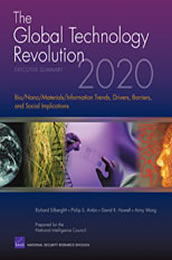BOOK REVIEW
THE GLOBAL TECHNOLOGY REVOLUTION 2020: IN DEPTH ANALYSES: BIO/
NANO/ MATERIALS/ INFORMATION TRENDS, DRIVERS, BARRIERS AND SOCIAL
IMPLICATIONS
By Richard
Silberglitt, Philip S. Antón, David R. Howell and Anny Wong et
al,
RAND,
2006, 314 pp, $30.00 (free PDF available online), ISBN: 0-8330-3975-X

Download options |
 |
|
DOI: 10.2966/scrip.050108.205 |
||
This report, conducted by a team of experts from the RAND Corporation for the National Intelligence Council (NIC), offers a vision of the current situation and the future trends of science and technology (S&T) acquisition capacities across nations. In doing so, it aims to provide “US policymakers with a view of how world developments [in the area] could evolve, identifying opportunities and potentially negative developments that might warrant policy action.” The report also relates these abilities to social and economic development, since it recognizes that “countries with less S&T capacity also rank lower in other areas, economic and social development, while countries with more S&T capacity rank higher.”
The information and conclusions of the report were collected and produced during 2004 and 2005. It covers three decades of profound changes and “convergence” of S&T developments and their incorporation into society in the areas of bio, nano and information technology. The authors predict that this rapid development pace will continue in the coming fifteen years. Therefore, countries will have to address bio, nano and information technology policies when thinking of the transformations of human life quality, increasing human lifespan and the changing faces of work and industry.
Only by recognising this broad framework can one understand the importance of the surveys collected by the RAND Corporation. Its findings and descriptions must serve policymakers around the globe, not only the United States, to analyse the changing S&T map. As the authors themselves admit, “while the US remains a leader in S&T capability and innovation, it is not the sole leader and thus will not always dominate every technical area.”
The authors focused their findings and predictions on the capacity of twenty nine selected countries to acquire sixteen S&T applications that they consider will be commercially available, worldwide, in 2020. The countries were selected from the major geographical regions were each one represents a group of similar nations; thus, the group illustrates the national differences within the region, while at the same time offering a diverse sample of nations. How do different countries acquire specific S&T applications? Will they acquire these applications through their own skills? Will it be with international aid? Or, will it be mainly through their economic power of acquisition? Once a country acquires a specific application, how is it implemented in the concrete social, economical and cultural environment? The survey, analysis and conclusions focus mainly on two axes: the capacity of a given country to develop or acquire S&T, and its ability to implement it on the basis of its very own drivers and barriers.
According to the data collected, the countries were classified in four different groups that measure the capacities to acquire or implement those S&T abilities: “advanced”, “proficient”, “developing” and “lagging.” Based on this classification, the authors offer a comprehensive analysis of the way the twenty-nine countries in the four identified groups prioritise the different areas regarding their individual circumstances.
The text is organized in four chapters which present the analysis of the data. The figures are detailed in eleven appendixes and supported on more than forty pages of references. The report includes many conclusions, but the authors themselves condense them as follows:
• “Regional and country-specific differences in social needs and S&T capabilities are resulting in differences in how technology is revolutionizing human affairs around the world,
• Regional differences in public opinion and issues may strongly influence technology implementation,
• Maintaining S&T capacity requires consideration and action across a large number of social capabilities and stability dimensions,
• Capacity building is an essential component of development, and
• Public policy issues relating to some technology applications will engender strong public debate.”
From a developing country’s perspective, the third chapter, “International variation in technology applications and implementation”, seems particularly interesting. In it, the authors discuss the possible impacts of the selected sixteen Technology Applications (TA) in different parts of the world. Among all the information presented, I would highlight how it confirms that law can be both a driver and barrier on the S&T field: “Laws and policies can create friendly or hostile environments that can promote or hinder technology implementation and exploitation. The passage of laws and enunciation of policies that explicitly promote or prohibit the use of a technology will significantly influence government, commercial, and individual decisions.” This statement is supported by several examples from fields as controversial as Genetic Modified (GM) seeds.
Even though the report’s target audience is American policymakers, we should not underestimate the impact its conclusions could have on other countries. While for policymakers in developed countries this report might be a tool to better understand ways to balance their leadership on the different S&T areas in their search for economic growth, a careful and critical reading from policymakers in developing countries should prove useful in helping these societies determine and choose their strengths in a global world. For policymakers in developing countries, the decision making process is much more important because their weaknesses, confirmed in this report, mean that they need to choose priorities by favoring certain areas in spite of others. Understanding the dimension of these decisions by contrasting other countries’ possibilities and outcomes is in itself an important and often overlooked exercise.
Carolina Botero, LL.M.
Ph.D. Candidate in Law,
Autonoma University Barcelona, Spain
Member of Fundación Karisma, Colombia
DOI: 10.2966/scrip.050108.X
© Carolina
Botero

This work is licenced under a
Creative Commons Licence.
Please click on the link to read the
terms and conditions.
